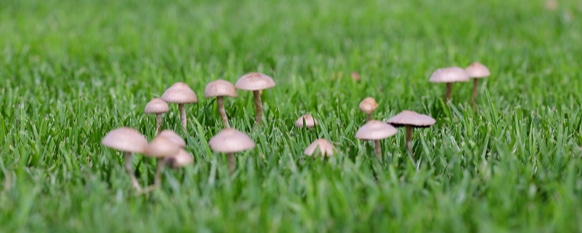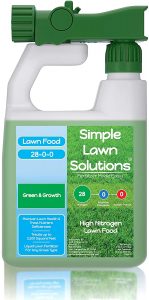Why do mushrooms show up? What does it mean for your yard when they show up? Which are poisonous and which are safe to eat? How do you get rid of them from your lawn?
The answers to each of those questions and more can be found right here in this article. We’ll also discuss common types of mushrooms that grow on your lawn.
If you like this article, you’ll want to check out our guide on identifying weeds with photos to help get rid of other invasive plants that may be popping up in your yard.
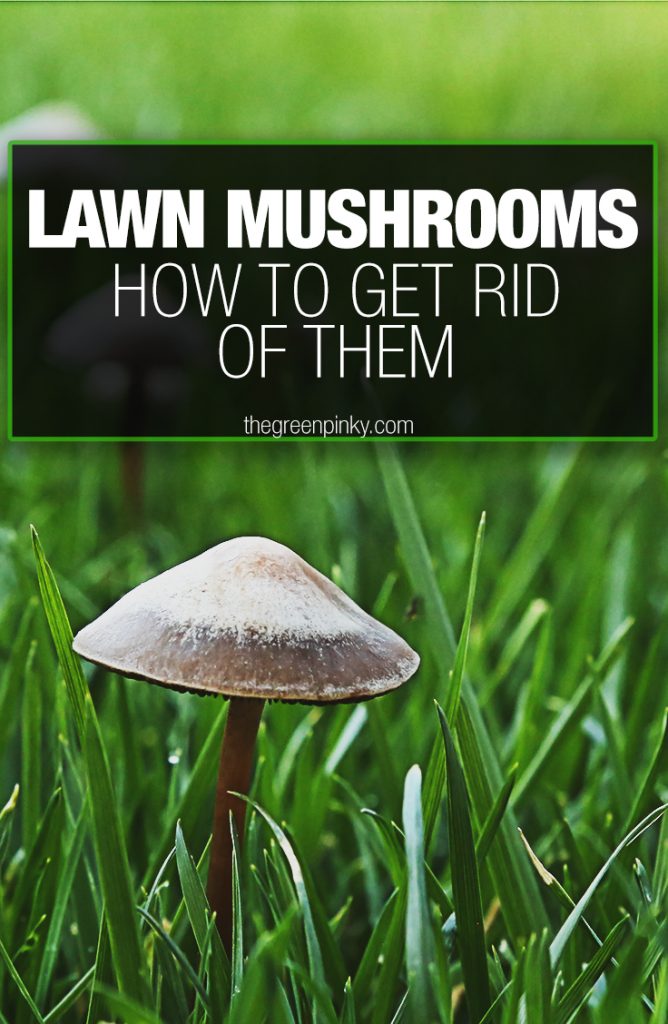
What You Should Know
It’s a common misconception that mushrooms are vegetables. I used to believe that very thing. I think most of us do until we look a little deeper into the matter.
Mushrooms are the fruiting bodies of fungi living in the soil. And, much like apples on an apple tree, mushrooms are a smaller part of a much larger fungal organism.
The true mass of the structure can be found below the soil and consists of a network of mycelia. Mycelium are fibrous strands that can extend for enormous distances.
This is important to understand in terms of getting rid of them. In every case, merely pulling the mushroom from the ground is doing very little to rid your property of the fungal structure. Essentially, you’ve only picked one or two apples off of a much larger tree.
If you want to keep them from growing in your yard, then you must remove the entire fungal network from the earth. Since these mycelium networks can be so vast, it can sometimes be harder than you would imagine.
Why Do They Show Up on Your Lawn?
Mushrooms are fickle fungi. They will only appear when the conditions are just so.
Some conditions that help them thrive include:
- Moisture
- Areas With Shade and Cool Temperatures
- Cloudy Weather
- Humidity
- Rich, Organic Material in the Soil
When you provide a space on your lawn that matches these environmental requirements, mushrooms will come to the surface. It could be under your shrubs, under a tree, or on the soil surface under your deck. They could appear on sod that has been laid down recently or even out in the middle of your lawn.
The fungal structure, including the mushroom fruit, breaks down organic matter in your soil and returns it to the roots as nutrients. While mushrooms assist the mycelium in that process, their primary function on the surface is to help spread their spores, the way they reproduce.
The mycelium and the mushrooms break down organic matter like plants, wood, and other natural debris and use them as a food source. This breakdown provides the mushrooms with sugars that feed the fungal structure.

What Does It Mean When it Shows Up in Your Lawn?
The presence of mushrooms can mean several things.
Mushrooms on your lawn often mean that your soil is becoming more nutrient-filled and healthier. As the fungus breaks down organic matter, it forms a mutually beneficial relationship with the soil.
In some circumstances, mushrooms are evidence of plant disease spreading through your lawn or garden. Pathogenic fungal organisms are responsible for most lawn diseases.
Damage caused by pathogenic fungal activity can include:
- Wilts
- Galls
- Leaf Spots
- Root Rot
- Stem Cankers
- Fruit Rot
Fungal infections are problems that can kill your lawn grass, ruin your vegetable garden, or affect the beauty of your ornamental shrubs and flowers. They can even rot out the center of a living tree by spreading their pathogens.
Conversely, beneficial fungi will protect your plant life from their pathogenic counterparts.
Mushrooms might also be a sign that you have compacted soil or soil with drainage problems. The water does not circulate freely in a certain area, and the moisture saturates it. This could be an open invitation for the mushrooms to set up camp in that area.
Encountering mushrooms may also mean that your thatch is too thick. A healthy layer of beneficial thatch should never exceed more than ½ an inch in thickness. Otherwise, the poor drainage causes water to pool on the surface of the thatch. Thatch is nothing more than decaying organic matter, which makes it a perfect place for mushrooms, especially if you have allowed it to become too thick.
Another potential cause could be that you are not picking up after your pets. Mushrooms thrive in poop. If you’ve been lazy with the pooper scooper and it’s rained recently or your dog hides it from you under the bushes, you might see mushrooms popping up on the animal waste in those areas.
Common Mushrooms
Are you confused about the fungal fruits springing up around your yard? Are they poisonous? Are they edible? These are all valid questions and concerns. Let’s look at some common lawn fungus that you might see coming to life on your property.
Shaggy Ink Cap (Coprinus)
This mushroom grows in a tall cylinder. It received its name because of the transformation it makes as it prepares to release its spores. The mushroom changes from a clean white, and swells into an inky black.
This change will happen when you pick them as well.
This inky fungus is beneficial to have in your lawn. It specializes in attracting and consuming nematodes, a microscopic soil worm.
The shaggy ink cap (aka shaggy mane or lawyer’s wig) is edible, so long as you prepare it before the mushroom changes color.
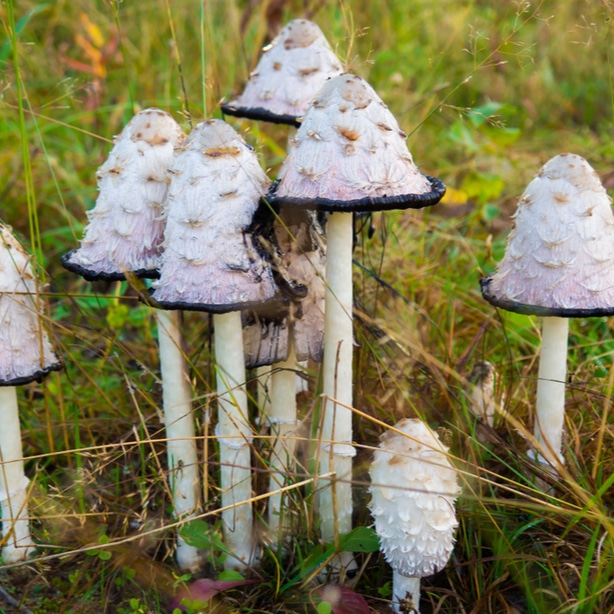
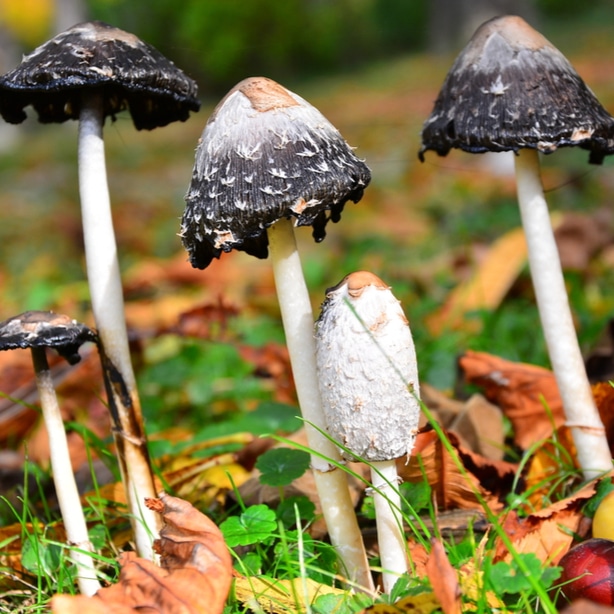
If you are trying to find a good desert tree to grow, make sure you check out our article where we go over some common desert trees.
Honey Fungus (Armillaria mellea)
This mushroom often appears near the base of a tree, a tree stump, or an area on our lawn where a tree has been removed.
It appears as clusters of honey colored mushrooms and rarely appears before the host tree is dead or in a serious state of decline. The honey fungus is pathogenic and will cause root rot.
You can eat them if you’d like, but some people have reported experiencing some digestive discomfort after consuming them.
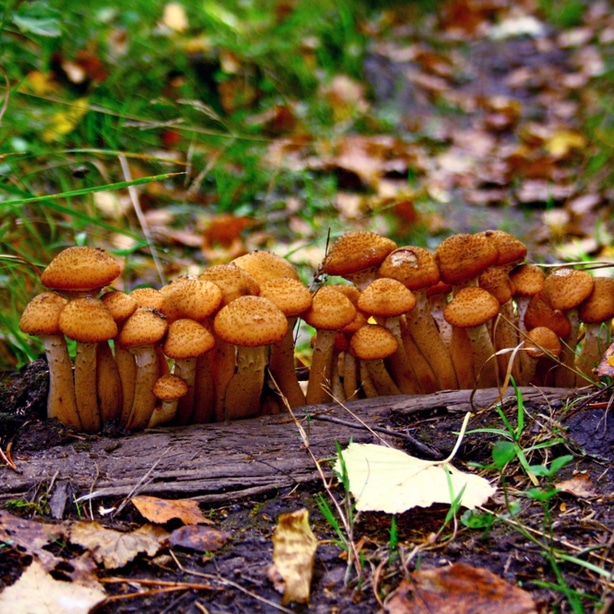
False Parasol (Agaricus campestris)
This is a large, white mushroom whose cap appears as a ball sitting atop its stem initially. Over time, the cap will open and flatten out. The cap has brownish patches that develop into scales. The gills of the mushroom begin white and turn into a gray to greenish-gray.
Though they may look like the portabellas that we all love, these are not edible. They will cause serious gastrointestinal issues. So be very cautious if your children are in the yard with these mushrooms.
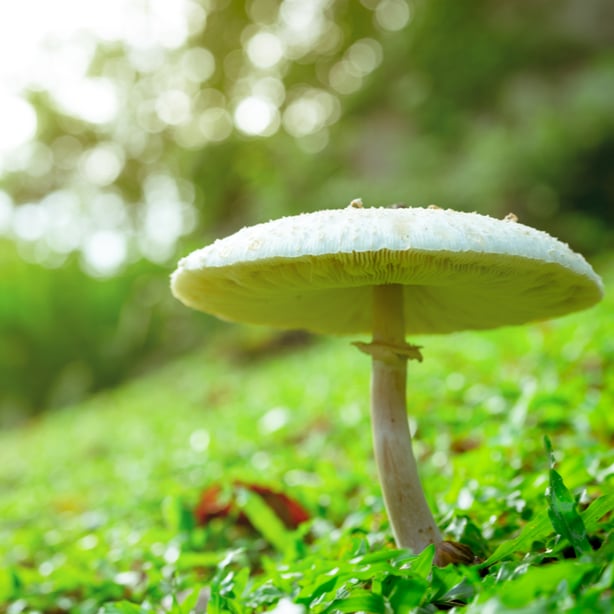
Meadow Mushroom (Agaricus campestris)
These are the lawn fungi that the false parasol are mistaken for. They look nearly identical, except the gills of the meadow mushroom are brown.
This mushroom is very edible and can be used in several fashions and still be delicious.
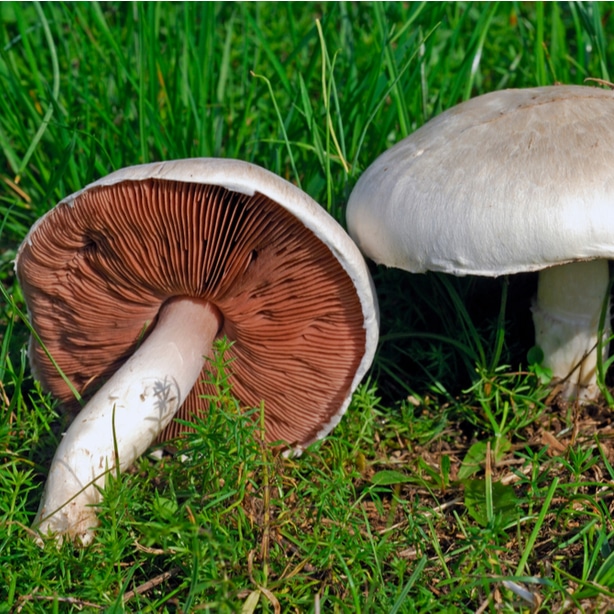
Stinkhorn Fungus (Phallus impudicus)
These fungi live up to their name. They are coated in a slime-like oil that produces a very strong and unpleasant odor that attracts insects. As the insects land on the stinkhorn, the slime acts as an adhesive that binds the spores to the bug’s feet.
An ingenious adaptation for reproduction.
The mushrooms resemble, well, just look at its scientific name. The first word describes the look of the fungus perfectly.
The stinkhorns are edible, but only in certain stages of its growth. Some places actually consider it a delicacy.
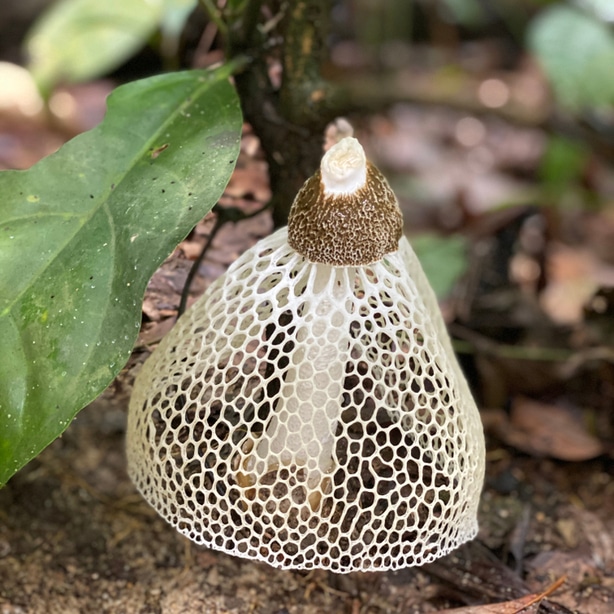
How Do You Get Rid of Them?
As we’ve discussed, mushrooms’ presence on your lawn is usually beneficial to the soil and the roots of the grass and other plants. They indicate that your soil is hard at work and strengthening itself through its symbiotic mycorrhizal relationship.
But the mushrooms themselves can be quite ugly and stick out like a sore thumb on your lawn. They are not essential to the breakdown of decaying organic matter in the earth. The mycelium is the lifeblood of the fungus. The mushroom is merely the fruit that spreads each spore across lawns for reproduction.
You can get rid of mushrooms without affecting the fungi’s ability to break down organic material. So let’s look at the different ways to get rid of the mushroom problem that appears from time to time.
Avoid Grasscycling
By leaving the grass clippings on your lawns, you leave a food for mushrooms to feast upon. So clean up any organic debris that you see accumulating on the turf. Leaves, sticks, etc.
Bag the grass clippings and follow the next method you’ll read about to supplement what you lose by removing them from your yard.
Use a Nitrogen Fertilizer
Nitrogen will speed up the decomposition of organic debris on your lawn.
Increasing the rate of decomposition causes the debris to be recycled faster and narrows the window of time that a food source for the toadstools is available for consumption. Decreasing that window will keep the fruiting bodies below the soil surface.
Nitrogen fertilizers with 28-0-0 NPK ratio like the one above can be found Amazon.
Practice Preventative Lawn Care
Proper preventative lawn care can include a multitude of tasks. Keeping your lawn healthy and lush is the key way of preventing not only mushrooms but a host of other issues you might experience.
Let’s discuss some different lawn care practices that you can use to prevent mushrooms from showing up on your lawns.
Dethatch Your Lawn
A thin thatch layer can be very beneficial to your grass, but you have to make sure you don’t allow it to become too thick.
Dethatching a thick layer of organic material will improve the drainage and reduce your thatch’s water retention.
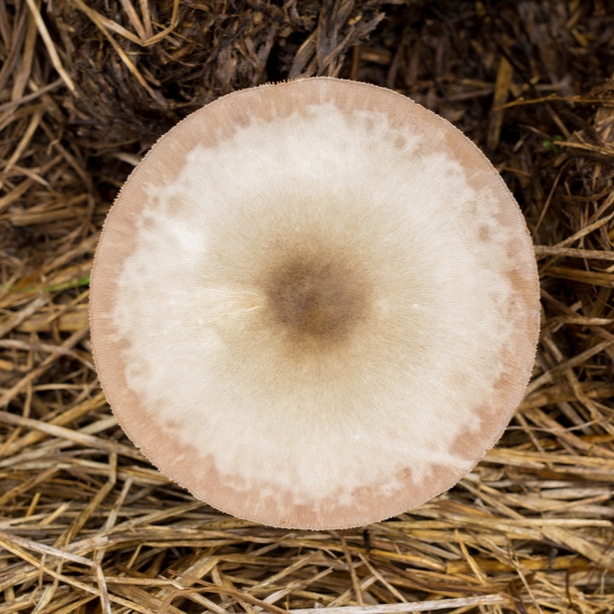
Aerate the Soil
Aerate your soil to improve drainage and allow nutrients, air, and water to flow readily to grass, plant, and tree roots. Aeration will also relieve compacted soil that forces water to pool on the surface instead of draining through the soil.
Spread Out Your Irrigation
Spread your watering sessions out over the week. If you water once a week for 30 minutes, then water twice a week for 15 minutes. Better yet, water 3 times per week for 10 minutes.
Changing your irrigation schedule will ensure that your grass is still receiving an adequate amount of water while avoiding soaking the soil. This will ensure that you aren’t saturating areas of your lawn and providing mushrooms with an ideal habitat.
Physically Removal
Try to remove fungus as soon as you see mushroom caps appearing on the ground. If you don’t catch them early, you allow them to release their spores.
The most efficient and effective way to remove the mushrooms is to pick them by hand. You can use a lawnmower or a rake, but you risk inadvertently assisting them in spreading their spores.
Don’t just throw the mushrooms into your compost pile and call it a day. While they would be beneficial in breaking down organic materials, they will also continue reproducing. When you go to spread your compost across your lawn, you’ll also be planting mushrooms.
Instead, bag them up and seal them up tightly when you finish. This is one more way to keep the mushrooms from reproducing.
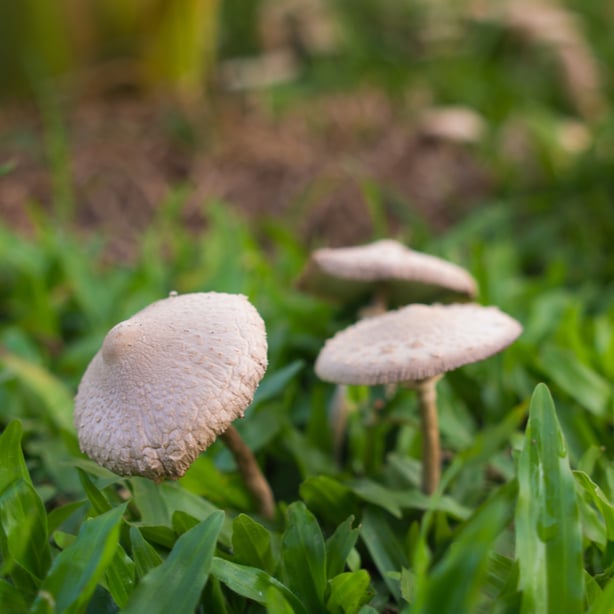
Repair Landscaping Problem Areas
Often a drainage issue cannot be corrected by merely aerating the soil. You must get a little more involved if this proves to be the case on your property.
Search the ground for problem areas.
If you notice that water is flowing down a slope and collecting in an undesirable spot, redirect the water into a more desirable location. This can be a drain, a rain garden, a catch basin, or other collection point or feature.
You can use rain barrels underneath gutter downspout or install a French drain beneath the soil to channel water back into the soil discreetly. There are several options to choose from to improve the flow of water around your lawn.
Don’t Bother With Fungicides
Fungicides will not penetrate the soil deep enough to hurt the mycelia. While the products will kill the fungal fruit on the surface, it’s only temporary. The reproductive caps will return at some point.
Besides, many fungicides designed to eliminate the shrooms have been banned and are illegal to use on lawns.

